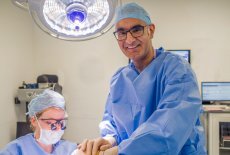Nose Reshaping (Rhinoplasty)
Who would benefit from this procedure?
Rhinoplasty is performed to improve nose shape, improve breathing or both. It may be purely cosmetic or after trauma (where the nose has changed shape after being broken). A full assessment of your nasal appearance and function is essential before any operation. It is important to be able to discuss particular concerns and desires at this stage to allow appropriate plans to be made. It is essential to mention any previous nasal surgery or trauma.
How is it done?
Rhinoplasty is performed under general anaesthetic, usually with an overnight stay. Small procedures can be done as day cases. Closed rhinoplasty uses incisions on the inside of the nostril and are not visible while open rhinoplasty uses a further incision just under the nose. The choice of incision depends on what needs to be done.
When only the shape of the nose requires changing the bridge of the nose is often addressed first if necessary. This may require the bones to be reshaped or to be reset. Resetting the bones is done by fracturing them and repositioning them. Here the cartilages can be reduced, reshaped or augmented. After this the mid part of the nose is attended to if necessary. This is where a hump may be reduced or a dip augmented on the area below the bridge of the nose. After this the tip of the nose is corrected, if necessary.
If the breathing needs correction as well as the shape then this is approached before any surgery to correct the shape is performed. The septum (the cartilage that runs down the middle of the nose and separates the two nostrils) is straightened by freeing it up of any scar tissue, realigning it and removing any cartilage that is particularly deformed. Once the septum has been corrected the shape can be attended to as described above.





What happens before surgery?
Mr Dheansa will fully assess you for suitability and any further procedures at the consultation. It is important to discuss specific desires and outcomes before committing to surgery. Knowledge of general health will help assess fitness for general anaesthetic. At the end of your consultation you should be clear about incisions, areas to be treated, length of stay and potential outcomes. If you are unclear about any aspect of your care or the procedure itself you should contact Mr Dheansa (contact details below) to clarify the situation before committing to surgery.
After the Surgery
What happens after the surgery?
When you wake up from the operation you will have supporting tapes on the nose and if the bones have been reset a splint to support the nose. These will remain in place for one week. You will find it difficult to breathe through the nose and this may be the case for a few weeks. Avoid blowing your nose. Your throat may become dry because you have to breathe through your mouth especially after you have slept.
There will be gauze packs within the nostril to stop any bleeding and these will be removed the day after the operation.
There will be some bruising and swelling around the nose and if the bones have been reset you will have black eyes. This bruising mostly goes by 2-3 weeks. You will be given some painkillers to help control any pain/soreness.
You will be sent home with some gauze to help absorb any ooze from the nose. This may need to be changed regularly.
One week after the operation the supporting tapes, external sutures (if present) and splint (if present) will be removed in clinic. You should notice a difference in the appearance of your nose at this stage but breathing through it may still be difficult. It is still early days and the nose may swell a little after removal of the tapes. This is to be expected. The general swelling of the nose will gradually improve over the next few weeks s0 that by 3 months it is fully settled (though it may take upto 12 months). This should also be the case for breathing through the nose. Any external scars may take longer to fully mature.
What should I expect post-op?
It will be difficult to breathe through your nose. Do not try to if it is not easy and avoid trying to clear your nostrils.
Bruising will become more obvious in the first few days after surgery and may take 3 weeks to resolve.
Some pain or soreness will be present but is usually controlled with pain killers.
Swelling and firmness of the nose may take months to settle and often occurs slowly.
What can I do and not do at home?
You will need to sleep as upright as possible for the first few days to help reduce swelling and avoid any strenuous activity for the same reason.
You should take your pain killers regularly. Avoid bending down and ensure you sleep as upright as you can. Avoid any strenuous activity for at least 2-4 weeks and only consider sport after 4 weeks or after discussion with Mr Dheansa.
Although you can shower avoid getting your splint wet as it is important it lasts the whole week for the bones to set well. You can shower normally after this. If you wear contact lenses you may find it harder to insert them. Equally wearing spectacles may be difficult with a splint and after this is removed you may need some padding to avoid soreness.
Do not blow your nose. Avoid cleaning out your nostrils as this may cause damage to the healing tissue.
Will my scars change?
All scars go through a maturing process and go through a series of changes before settling down. This process varies from person to person as well as from site to site on the same person. Generally once a wound has healed the scar will be a thin pale line. Over the ensuing 6-12 weeks the scar may become raised, pink and wider. It often becomes itchy too. It then stabilises before slowly becoming flatter, paler and less itchy. This can take up to a further 12 months. Even after this time scars continue to improve but at a much slower rate.
Avoid sunlight on the scar for the first year to avoid it getting burnt and then subsequently dark. It is very hard to make it pale again. Mr Dheansa will advise you of any further precautions or actions if required.
Follow up and after care
You will be reviewed in clinic regularly until everything has settled. It usually takes 3 months to do so but it may take longer. At this point if all is well you will be discharged.
Things to Consider
It is important to be prepared before and after your surgery. Here are a few things to consider about this operation.
Bruising and Swelling
If the bones have been reset you will have black eyes and these will take 2-3 weeks to get better. The nose itself will get swollen after the tapes (and splint) have been removed and again this will take a few weeks to get better. However there may be a little swelling that persists for 3-12 months though this is usually mild. Rarely there is persistent swelling that hides the improvement gained by surgery. This can be due to persistent scarring under the skin which may require further surgery but can be difficult to fully resolve.
Breathing
Changing the shape of the nose can sometimes affect the breathing. In the first few days and weeks after the operation, swelling inside the nose may make it difficult to breathe through the nose easily. This usually settles. In a small number of people the change in shape is significant enough to impair nose breathing long term. Equally if the operation is specifically to improve the breathing, sometimes the amount of improvement is not as much as you may have wanted.
Nostril Show
Changing the shape of the nose can affect many parts of the nose and often surgery to the bones and or the tip can result in the nostril being more exposed. This is not always predictable and is dependant on all the changes that occur.
Smell
Very rarely the sense of smell may change after surgery. It is very difficult to address this should it occur.
Over-correction
As with all surgery it is impossible to guarantee precise removal of tissue to correct the shape of the nose though this is always the intention. The difference between taking just the right amount and too much is sometimes very small. This might mean that if, for example, a hump on the top of the nose is being removed that instead of being straight there is a slight inward curve or if the tip is being reduced that the tip becomes slightly pinched. It is important to remember that it is difficult to imagine exactly how your nose will look afterwards and often the surgeon will explain what is and what is not possible for you.
Under-correction
In certain situations the reverse is true in that you may feel not enough tissue has been removed. Again it is a fine line between taking the right amount and just not enough. Sometimes the anatomy of the nose or previous scarring may warrant erring on the side of caution to avoid taking too much tissue away.
Abnormal Scars
Sometimes even if all heals well a patient may develop abnormal scars (pink, wide, raised and itchy). Patients may already have noticed such a tendency from previous scars. Such scars take a very long time to settle (up to 18 months) if at all and may be difficult to treat.
Asymmetry
People are rarely exactly symmetrical and the intention of any surgery is to get both sides as equal as possible. However, the healing process is not always predictable and may result in differences from one side to the other.
Pain
Usually controlled with painkillers and again often resolves within a week or so.
Numbness
The treated area will lose sensation (feeling) after the operation and it will take several weeks for it to return. Some areas may remain numb.
Clots
Clots in the leg (DVT) lungs or chest infection are uncommon with this operation.
Sensitivity
This is most likely if the area is not regularly massaged and moisturised.
Are there any potential risks?
There are potential risks and complications with any operation and it is important to be aware of them before committing to any surgery. You may also have particular circumstances that affect the final outcome and these will be discussed with you at your consultation.
Anaesthetic
You will be assessed for fitness for anaesthetic and providing this is appropriate the risks from general anaesthetic are low. Anaesthetic can sometimes cause a reaction though this is very rare.
Bleeding
Minor bleeding from the nose soon after the operation is not unusual and is often controlled with gauze packs. There may be a little bleeding after the packs are removed but this soon settles. Rarely a patient may experience significant bleeding from the nose that is not stopped by the packs. If this should occur you may have to go back to theatre to insert special packs to control the bleeding.
Wound Infection
Wounds can very occasionally get infected. If you notice increasing redness, pain or an offensive odour from the wound, contact Mr Dheansa as soon as possible. If this should occur you will need to have antibiotics and frequent dressings. The wound may take longer to heal and the resulting scar may be less than perfect.
Small Bumps
Occasionally you may be able to feel (or rarely, see) small bumps at the site where the bones have had to be reset. This is more likely if you have thin skin. These often resolve but in a few people they persist and may require a minor operation to improve them.
Download Procedure Information
Download Consent Form
Frequently Asked Questions
How long is the operation?
About 90 minutes.
When can I shower?
You can shower straight away but need to avoid washing your face or getting your splint wet. After the splint has been removed you can shower normally.
How long should I keep taking pain killers?
You will often need pain killers for at least a week but everyone is different you may need to take them for longer.
When can I go to the gym?
You should avoid the gym till about 4 weeks after the operation but check with Mr Dheansa first.
How long until the final result?
3-12 months.
When can I fly?
Generally it is ok to fly 2-3 weeks after the surgery but this depends of length of flight and your recovery. Check with Mr Dheansa before flying.



